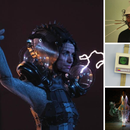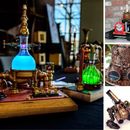Introduction: DIY 4X5 Camera Scan Back
This is a tutorial for making a DIY camera scan back for a 4X5 camera. I made this to work with a Graflex Series B camera which at one point was one of the top-of-the-line cameras. It long ago belonged to my Great Great Uncle Nat who was a commercial photographer for JCPenney in the 1930s.
My reason for making this scan back was because the camera was broken when I received it, and it could no longer be used to take film photos. The shutter cloth in the back had rotted, and the cost of sourcing a new one and repairing it was more than buying a working antique Graflex camera to begin with.
Nevertheless, I told the family member who gave me the camera that I was going to somehow get it working again. I began to explore options for taking photos without a working shutter. One of my ideas involved putting a sheet of ground glass in the back, and scanning it. That is when I stumbled upon camera scan backs.
Unfortunately, I quickly realized a commercial camera scan back costs thousands of dollars. Undaunted, I simply decided to make my own for much cheaper. The cost of making this project is about $200.
Of course, for $200 you get what you pay for. This scan back only works in black and white, the photo in unevenly illuminated, and, as you can see, the rings from the fresnel lens show up overlaid atop the graphic. These are not the best digital pictures in the world, and it would be fair to say that the photos that result are a bit of an acquired taste.
While I would get much better results simply by buying a 4X5 adapter plate for my Canon DSLR, I feel like this scan back is more in the spirit of shooting film with this camera. For starters, I can make use of the camera's native SLR mechanism (one of the first of its kind), which would not be necessary when shooting digital photos. Also, there is a kind of "development" involved since I can't see what I am shooting until I load it onto the computer. Also, there is unexpected artifacts and graininess like you would see with film, especially when shooting moving subjects.
It is the combination of antique technology and the element of surprise that makes using this 4X5 scan back with my camera so fun. I wouldn't say these are the best photos I've ever taken, but I had a great time getting this family heirloom working again.
Step 1: Scanning the Image
If you simply place the scanner in the back of the camera where the 4X5 film cartridge normally goes, and scan the frame you will get a reasonably high resolution but narrow "keyhole" image.
It's difficult to figure out what part of the frame you're going to capture, but you will definitely get a high resolution photo.
Step 2: Adding a Lens
By adding a fresnel lens on top of the scan bed, you can more evenly disperse the light and get a full frame picture. However, the trade-off here is that the scanner light reflects off of the lens and you can see the lens itself overlaid on every picture.
This results in a blurrier and lower quality full frame image.
I decided to go this route and add a lens because I was more concerned about capturing the full frame than making high quality photos. Nevertheless, what I am about to show you can be built with or without the lens (to your preference).
Step 3: Materials
For this project you will need:
(x1) Flip Pal portable scanner (or similar)
(x1) 5 x 7 Fresnel Lens
(x1) 12" x 12" x 6mm black acrylic
(x1) 12" x 12" x 3mm black acrylic
(x8) 3/8" x 6-32 flathead bolts
(x1) Roll of heavy duty 3M tape
(x1) 12" x 12" square black vinyl ***
Tools required:
(x1) Laser cutter (or appropriate plastic cutting saws)
(x1) Drill press
(x1) 3/8" x 82 degree countersink bit
(x1) Drill press vise
(x1) Tapping machine (or tap wrench)
(x1) 6-32 tap
(x1) Hex wrench set (or screwdriver)
(x1) Vinyl cutter***
*** This is very optional! I used it because I had it, but you can get the same results with a black Sharpie or some black electrical tape.
Step 4: Laser Cut Parts
Download the attached laser cut files.
It should be pretty straight forward what to do, but if it's not, here are some instructions:
- Laser cut the one labeled EigthAcrylicVectorCut.eps out the 1/8" acrylic.
- Laser cut the one labeled QuarterAcrylicVectorCut.eps out of 1/4" acrylic.
If you don't have a laser cutter, can't find one at a local makerspace, nor want to pay a service bureau to cut the parts for you, then you can use the files as templates and use traditional shop tools to cut them out. Check out this amazing guide on doing digital fabrication by hand.
Step 5: Thread the Holes
Thread all of the holes in the 1/4" acrylic using a 6-32 tap.
Step 6: Countersink
Countersink the holes on one side of the larger 1/8" acrylic piece using a drill press.
The idea is to make the countersinks just deep enough that the 6-32 flathead bolts lay about flush when inserted.
Step 7: Peel and Stack
Peel the protective coating off of the black acrylic.
Stack them such that the 1/4" piece is on the bottom, the smaller 1/8" piece is in the middle and the larger 1/8" piece is on top with the countersinks facing upwards.
Step 8: Bolt Together
Bolt all three pieces together with the 3/8" x 6-32 bolts.
Step 9: Cut a Cover (optional)
Download the attached vinyl template and cut it out using your vinyl cutter of choice.
This will be used to cover the heads of the 6-32 bolts so that the scanner does not see them, and to prevent them from reflecting light.
Attachments
Step 10: Cover the Bracket
Cover the side of the bracket where the bolt heads are showing using the black adhesive vinyl from the previous step.
If you don't have a vinyl cut adhesive cover, then you can use some black electrical tape or just draw over the heads of the bolt with a black marker.
Step 11: Place the Fresnel Lens
Place the fresnel lens centered atop the scanner bed with the smooth side of the lens facing upward.
Step 12: Double Sided Tape
Place high strength double-sided tape all along the edges of the scan bed atop the fresnel lens.
The idea is to make sure that you have taped down the lens during this process.
Step 13: Stick on the Bracket
Center the bracket's opening atop the scanner bed and stick it down.
Step 14: Clean It Up
Cut away the excess tape, or cover the tape with more black acrylic.
To be honest, the first time I did this I cut the tape away, and it lost some structural integrity.
I later redid it by cover the exposed tape with leftover black vinyl and this worked very well.
Step 15: Attach the Scan Back to Your Camera
Attach the scan back to your camera as you would any other camera back.
You are now ready to begin shooting!
Step 16: Shoot Some Photos
One thing to keep in mind when shooting photos is that your subject needs to be very brightly lit.
Also, on account of the depth of the acrylic bracket, the scanner bed is spaced back about 1/2" from the normal focal plane. To account for this, get your subject in focus and then manually move the bellows in about 1/2".
Another helpful thing I learned is that it makes no difference whether or not the back of the scanner's see-through window is covered. Don't worry about this letting light in.
Lastly, if your subject moves while scanning it, you can get some fun and interesting results.
PLEASE NOTE!
If anyone can figure out a way to make the scanner work without the scanner's light turning on (the light is required for calibration before every print), I will be your friend forever!

Did you find this useful, fun, or entertaining?
Follow @madeineuphoria to see my latest projects.






